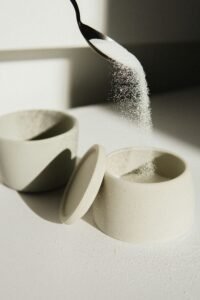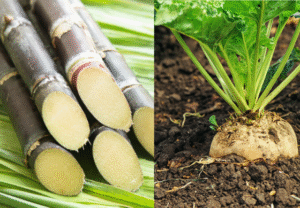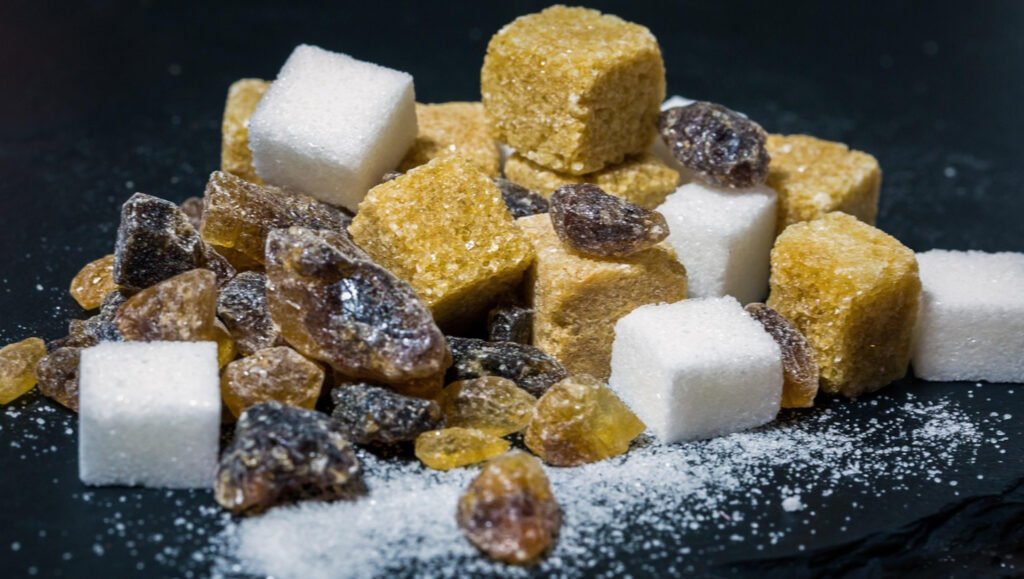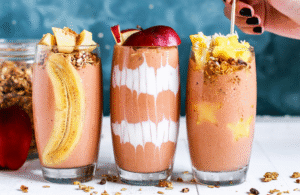This page contains affiliate links. We may earn a commission. Learn more
Contents
ToggleWhat Makes the Best Candy Floss Sugar?
Candy floss is sugary magic – but not all sugar is created equal! The type of sugar you use can affect the taste, texture, and even colour of your fluffy treat.
Before we dive into different sugars, let’s talk about what makes good candy floss sugar.
✔ Fine granules – Helps the machine spin it into thin, delicate threads.
✔ High purity – Too many impurities can clog the machine and affect the texture.
✔ No added moisture – Sugar should be dry to avoid clumping.
✔ Melts evenly – So it spins properly without burning.
Granulated is your classic candy floss sugar but for those looking for a more natural option they might want to use organic cane sugar or perhaps give an unrefined sugar a spin. Want to try and make a sugar free candy floss – well you do have some options.
But which sugars and non-sugars will work in your candy floss machine – and if they do work what will they taste like.
Let’s take a look at all of your sweet options:
Classic Granulated Sugar (Best All-Rounder)
 If you want traditional candy floss, regular white granulated sugar is the go-to option.
If you want traditional candy floss, regular white granulated sugar is the go-to option.
It consists of fine, white crystals made from either sugar cane or sugar beet, and is highly refined to remove impurities and moisture. Its dry texture, consistent grain size, and neutral flavour make it ideal for spinning into light, fluffy candy floss.
Granulated sugar melts evenly and flows smoothly through candy floss machines, producing consistent results every time. It’s also easy to colour and flavour, making it a perfect base for a wide variety of candy floss creations—from traditional pink vanilla to bold custom blends.
Caster sugar is a type of granulated sugar that is very fine and so this also works a treat for your treat.
✅ Pros: Cheap, easy to find, works in all machines.
❌ Cons: The flavour is simply sugar – although I do appreciate that this will not actually be a con for some people.
Flavoured and Coloured Sugar
Want pre-made flavoured sugar? These will have extracts or powders already added to them and come in a huge range of fun colours and tastes, such as:
🎈 Strawberry (pink)
🎈 Blue Raspberry (blue)
🎈 Bubblegum (purple)
🎈 Apple (green)
🎈 Mango (yellow)
🎈 Toffee (brown)
✅ Pros: Instant flavour and colour, no extra mixing needed.
❌ Cons: Slightly more expensive than regular sugar.
Best Beginner Flavours | Great Starter Kit | Spoilt For Choice |
Gold Medal 3 Pack (3 x 227g) | Misskandy 5 Pack (5 x 300g) | Baking Beauty and Beyond 1 x 200g pack |
Classic flavours from the fairground with vibrant colours. The sugar produces very fluffy floss and the taste is extremely good. It works out more expensive that the other options we show here but this is high quality candy floss sugar that it would be hard to go wrong with. | Feeling a little bit more adventurous. This is a good selection of flavours with enough variety to satisfy most sweet palettes. The crystals are a little on the large side but they produce a lovely tasting candy floss with good colour. This pack should last a long time so the storage containers are handy and the sticks are a welcome bonus. | Feeling experimental – with over 70 flavours to choose from (and combine) you can have a truly sweet adventure with these sugars from Baking Beauty and Beyond. With such variety you are going to find that some colours are not as vibrant as you’d like and some flavours are not as strong as you’d like but they will all make decent candy floss and you are a certain to find a flavour that you love. |
Organic Sugars
 There are several different types of organic sugar, which vary based on how they are processed, their source, texture, flavour and colour. Organic sugar refers to sugar produced from organically grown sugarcane or sugar beets without synthetic pesticides, herbicides, or chemical fertilizers.
There are several different types of organic sugar, which vary based on how they are processed, their source, texture, flavour and colour. Organic sugar refers to sugar produced from organically grown sugarcane or sugar beets without synthetic pesticides, herbicides, or chemical fertilizers.
✅ Pros: Less processed, contain natural minerals.
❌ Cons: Darker colour may affect candy floss appearance, and some organic sugars don’t melt as smoothly.
Before you get too excited about going Organic though there is only real one winner in this category – Organic White sugar. There are other organic sugars that you can use to make candy floss but they are not ideal and you may be putting your machine at risk. There are then some that you really shouldn’t use and a few that you just won’t be able to use.
Here is a summary:
🍬 Organic White Sugar
Description: A refined sugar made from organically grown sugar cane that comes in fine, white crystals and has a neutral flavour. It is more refined than other organic sugars but still from organic sources. During processing it is typically whitened using non-chemical methods (such as bone-char-free filtration) making it a more environmentally and ethically conscious.
It behaves very similarly in candy floss machines to more processed sugar spinning easily and producing fluffy, consistent results.
Uses: All-purpose sweetener, baking, beverages.
For Making Candy Floss
Pros:
✅ Clean, neutral flavour
✅ Consistent melting and spinning
✅ Ideal for adding flavours and colours
Cons:
❌ Lacks any extra flavour (if that’s desired)
❌ Slightly more expensive than standard white sugar
🌾 Organic Raw Cane Sugar
Description: Slightly coarse crystals with a light golden colour. There is minimal processing – only the molasses-rich outer layer is removed leaving a flavour with subtle natural molasses with hints of caramel, toffee and sometimes even smoky or liquorice-like notes.
Uses: General sweetening, baking, coffee, cereals.
For Making Candy Floss
Pros:
✅ Less processed; more natural flavour remains
✅ Organic option with mild molasses notes
Cons:
❌ May clog candy floss machines due to molasses content
❌ May not spin as cleanly or consistently
If you like the idea of a richer tasting candy floss with a light golden colour and are willing to put in a bit of effort then there is no reason why you can’t have yourself a Candy Cane Floss Creation.
It is an undertaking, and a risk to your machine – but if you prepare correctly then you are in for a golden sweet taste sensation!
Our top pick for Organic Raw Cane Sugar on Amazon is Wholefood Earth Organic Golden Cane Sugar
If you want to give it a go then here are the steps we recommend taking:
Grind it and Dry it
As the raw cane sugar crystals are too large for most candy floss machines you need to use a blender, food processor or spice grinder to reduce the grain size. You are aiming for a texture similar to regular granulated sugar – not powdery like icing sugar.
Now comes the drying out part necessary to prevent clumping and poor spinning.
Spread the sugar on a baking tray and place it in an oven at low heat (about 50–70°C / 120–160°F) for 30–60 minutes. Let it cool to room temperature before giving it a spin.
Even after this preparation I would suggest you still proceed with caution and start out with a small test batch just in case you’re your sugar is still too moist or coarse.
You do not want clumping, clogging or overheating and so you need to watch for signs of caramelisation or burning.
⚠️ Signs Your Sugar Is Too Moist:
Clumping
- Sugar sticks together in lumps, especially after grinding or drying.
- It doesn’t pour smoothly or feels slightly sticky to the touch.
Caramelising or Burning in the Machine
- Instead of spinning into floss, the sugar starts to brown or smoke.
- You may see bubbling, dripping, or hardening around the spinner head.
Little or No Candy Floss Forms
- The sugar melts but doesn’t spin properly—it just gets hot and sits there.
- If floss does form, it’s sticky, stringy, or very sparse.
Machine Head Sputters or Spits
- The machine might make strange noises or struggle to spin evenly.
⚠️ Signs Your Sugar Is Too Coarse:
Loud Crunching Sounds
- You hear the machine grinding or cracking as it tries to process the large crystals.
Sugar Bounces or Shoots Out
- Instead of melting, sugar particles fly out of the spinner head.
Floss is Uneven or Sparse
- Only small amounts of candy floss are produced.
- You get patchy, clumpy results instead of smooth, fluffy strands.
Damage or Clogging
- The machine may clog, overheat, or vibrate excessively.
- Coarse sugar can wear out the heating element faster.
✅ Quick Test Before Spinning:
Rub It Between Your Fingers
- If it feels smooth and dry (like table sugar), it’s ready.
- If it feels gritty or damp, it needs more grinding or drying.
🍯 Organic Turbinado Sugar
Description: Large, golden-brown crystals with a mild molasses flavour. It is steam-cleaned raw sugar with some molasses retained.
Uses: Baking, topping for muffins/cookies, sweetening drinks.
For Making Candy Floss
Pros:
✅ Mild molasses flavour for a richer taste
✅ Organic and more natural
Cons:
❌ Coarser crystals may jam some machines
❌ Higher moisture and molasses can burn or smoke
🍂 Organic Demerara Sugar
Description: Large, crunchy, light brown crystals. Less processed than white sugar, retains some molasses.
Uses: Topping for baked goods, cereals, in tea and coffee.
For Making Candy Floss
Pros:
✅ Crunchy texture and caramel-like notes
Cons:
❌ Not ideal for spinning – large crystals and molasses interfere
❌ Can cause a sticky build-up in machines
🍪 Organic Caster (Superfine) Sugar
Description: Finer than granulated but not powdered.
Uses: Meringues, whipped cream, cocktails.
For Making Candy Floss
Pros:
✅ Fine texture helps smooth spinning
✅ Melts evenly
Cons:
❌ Slightly more expensive
❌ Needs to be very dry to work well
🟤 Organic Coconut Sugar
Description: Sap of coconut palm flowers. Brown, granulated sugar with a caramel-like taste.
Uses: Baking, sweetening drinks, healthy sugar alternative.
For Making Candy Floss
Pros:
✅ Low-GI and caramel-like flavour
✅ More natural option
Cons:
❌ Not suitable for most candy floss machines
❌ High moisture content can cause burning or gumming
🍁 Organic Maple Sugar
Description: Dehydrated maple syrup. Fine powder or crystals with a distinct maple flavour.
Uses: Baking, oatmeal, topping.
For Making Candy Floss
Pros:
✅ Unique maple flavour
✅ Melts relatively well
Cons:
❌ Expensive
❌ Can cause browning if too hot
🍫 Organic Brown Sugar
Description: Moist texture, rich molasses flavour. Made by adding organic molasses to organic white sugar.
Types:
- Light Brown – mild flavour.
- Dark Brown – more molasses, deeper flavour.
Uses: Baking (cookies, cakes), sauces, marinades.
For Making Candy Floss
❌ High molasses content makes it unsuitable for candy floss
❌ Can burn, clump, or cause excessive smoke
🍰 Organic Powdered (Confectioners’) Sugar
Description: Finely ground organic white sugar mixed with a small amount of organic cornstarch.
Uses: Icing, frosting, dusting desserts.
For Making Candy Floss
Cons:
❌ Not suitable for spinning—contains cornstarch and clogs machine
❌ Doesn’t crystallize into threads
🌾 Organic Date Sugar
Description: Ground dried dates. Granular, with a fruity flavour.
Uses: Baked goods, cereals, energy bars.
For Making Candy Floss
Cons:
❌ Doesn’t melt properly—grinds rather than spins
❌ Not recommended for candy floss
🌴 Organic Palm Sugar
Description: Sap of various palm trees (including date, palmyra, and coconut). Granular or cake form, similar to coconut sugar.
Uses: Asian cooking, baking, natural sweetener.
For Making Candy Floss
Cons:
❌ High moisture and molasses content
❌ Not good for spinning—tends to gum up machines
Unrefined Sugars
These are the least processed forms of sugar, retaining much of the natural molasses and minerals from the original plant (usually sugarcane or sometimes sugar beet). Unlike refined sugars, they are not chemically bleached or heavily filtered.
For making Candy Floss there is no real winner here. There are some options which you can certainly give a try, and once again there are some options I definitely would not recommend trying.
Here is a Summary:
🟤 Jaggery (Gur / Panela / Piloncillo)
Description: Made from Sugarcane or palm sap. It comes in blocks, cones, or granules and has a dark golden to brown colour. It has a flavour that is rich, caramel-like and slightly smoky.
Uses: South Asian and Latin American cooking, desserts, beverages.
Regional Names:
- India/Pakistan: Gur
- Latin America: Panela, Piloncillo
- Sri Lanka: Kitul jaggery (from palm)
For Making Candy Floss
Pros:
✅ Very rich flavour
✅ Unrefined, traditional sweetness
Cons:
❌ High molasses content = burning/smoking
❌ Hard block form needs grinding and still may not spin properly
🟠 Turbinado Sugar
Description: Partially refined raw sugar that retains some molasses. It has a light golden colour and comes in large, dry crystals with a mild molasses taste.
Uses: Tea, coffee, baking, sprinkle topping.
For Making Candy Floss
Pros:
✅ Mild molasses flavour
✅ Coarser option that some machines can handle
Cons:
❌ Still borderline – too moist for best results
❌ Not ideal for consistent floss
🟤 Demerara Sugar
description: Originally from the Demerara region of Guyana with large and crunchy crystals. It has a pale amber colour and a light molasses or toffee flavour.
Uses: Coffee, tea, crumble toppings, cookies.
For Making Candy Floss
Pros:
✅ Adds subtle molasses note
Cons:
❌ Large crystals and moisture content hinder spinning
❌ May cause clogging
🌴 Unrefined Coconut Sugar
Description: Made from the sap of coconut palm and comes in granules form. It has a golden to brown colour and a caramel-like with a slightly nutty coconut flavour.
Uses: Baking, sweetener substitute, beverages.
For Making Candy Floss
Pros:
✅ Lower Glycaemic Index which will appeal to the health conscious
✅ Unique Flavour which could result in a more gourmet-style candy floss.
Cons:
❌ High Moisture Content which can cause clumping or caramelisation instead of spinning properly.
❌ Not Ideal for Standard Machines as it might cause clogging
🍯 Muscovado Sugar (Barbados Sugar)
Description: Sticky, moist, and clumpy with a high molasses content. It has a dark brown colour and a deep, intense molasses flavour.
Uses: Rich cakes, barbecue sauces, marinades, gingerbread.
For Making Candy Floss
❌ Too moist and sticky—won’t spin
❌ Likely to damage or clog machines
🌾 Rapadura / Panela / Raspadura
Description: Evaporated cane juice (not separated from molasses) that comes in powder or block form. It has a golden brown colour and a mild to rich molasses, natural, earthy flavour.
Uses: Hot drinks, desserts, baking.
Notes:
- Rapadura (Brazil)
- Panela (Colombia, Ecuador)
- Raspadura (Cuba)
For Making Candy Floss
❌ High in molasses, low melt quality
❌ Not suitable for standard candy floss equipment
🟫 Sucanat (SUgar CAne NATural)
Description: Made From whole cane juice—dried and granulated with coarse, dry granules. It has a dark brown colour and a strong molasses flavour.
Uses: Baking, natural sweetening alternative.
For Making Candy Floss
❌ Too coarse and moist for spinning
❌ Can lead to clogging and smoke
🟤 Molasses
Description: Thick syrup, a by-product of sugar extraction. It has a rich, bold taste that is great for flavouring.
Types: Light, dark, and blackstrap (very strong and bitter).
Uses: Gingerbread, barbecue sauces, baked beans, old-fashioned candies.
For Making Candy Floss
❌ Cannot be used in floss machines (liquid form)
❌ Completely unsuitable for candy floss
Alternative Sugars
Some people wonder if you can make sugar-free candy floss. The answer is… sometimes – but only with the right equipment!
You will need a machine that is rated for sugar-free sugars – and these tend to be commercial grade.
Property | Sugar | Isomalt | Xylitol |
Melting Point | ~186°C | ~145°C | ~94°C |
Caramelises Well | ✅ | ❌ | ❌ |
Safe for Flossing? | ✅ | ✅ | ❌ |
Crystallisation Type | Threads easily | Threads (with effort) | Doesn’t crystallise into threads |
Isomalt
Description: A sugar alcohol derived from beet sugar. It has a Low glycaemic index, is tooth-friendly, and heat stable.
Uses: Common in professional sugar art because it stays clear and doesn’t crystallise easily.
It is not suitable for regular home candy floss machines. You should check the manufacturers manual to confirm if it is safe.
Sticky residue from isomalt may require more cleaning than sucrose.
Overheating can cause yellowing or burning of isomalt.
Xylitol
Description: It is a Sugar alcohol (or polyol) that is found naturally in small amounts in fruits (like strawberries), vegetables, and trees (like birch). It looks like sugar, and has a similar sweetness with about 40% less calories
Uses: It is commonly used in low-carb or sugar-free desserts. It is also used in toothpaste, mouthwash, chewing gum, mints, lozenges, chocolate and jams. It does not caramelise or behave like sugar in all recipes.
Works in some machines but melts faster than sugar.
- Melting point issues: Xylitol melts around 94°C (lower than sucrose, which melts at ~186°C), and it doesn’t caramelise or behave the same way when spun.
- It can clog or damage machines: Most domestic candy floss machines are designed for sucrose (table sugar) and can burn or jam with sugar substitutes.
- Lack of crystallisation: Candy floss relies on sugar recrystallising into threads as it cools. Xylitol doesn’t do this well.
🚫 Stevia, Truvia & Erythritol
Do NOT work (they don’t melt like real sugar).





